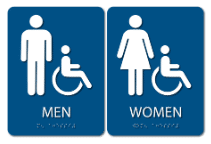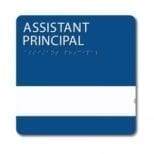So the question – what rooms require ADA Braille signs?
The key thing to remember is that if it’s a room that is not likely to change, you
are required to have a compliant ADA sign identifying it. Most rooms fall under this designation. Restrooms, vending areas, closets, etc. tend not to change function often and are required to have ADA signs.
An example of a room that might change functions often is a classroom (this year it’s Mz. Jone’s Science classroom but next year it may be Mr. Smith’s Art classroom). A smart option for rooms that change uses or occupants often is to use an insert sign that identifies a room number with tactile text and Braille but has a changeable insert for the name.
Remember, even if an ADA sign is not required, it’s still a good idea… making our buildings accessible to everybody is the right thing to do! The cost to identify a room with an ADA sign versus a non-ADA sign is only a few dollars more.
The Department of Justice has the ultimate responsibility for enforcing ADA regulations. In practice, though, the actual enforcement is handled by local code inspectors. Be sure to check with your local authorities before ordering!
Visit
ADA.gov for more information.




